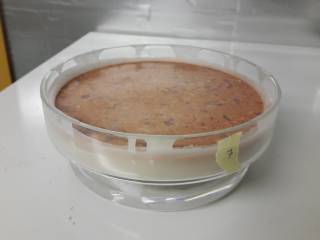 The aim of the study is to determine the material’s vapour permeability. The test is based on the even flow of moisture. In a glassy test cup a saturated salt solution is prepared, which causes a specific relative humidity above the surace of the solution. The sample is placed above the solution and the gap between the cup and the sample is sealed with wax. The cup is taken to a climate room, that has a constant temperature and relative humidity (different than inside the cup). The difference in water vapour content between the different sides of the sample causes a moisture flow through the sample, which can be observed by weighing the cup regularly.
The aim of the study is to determine the material’s vapour permeability. The test is based on the even flow of moisture. In a glassy test cup a saturated salt solution is prepared, which causes a specific relative humidity above the surace of the solution. The sample is placed above the solution and the gap between the cup and the sample is sealed with wax. The cup is taken to a climate room, that has a constant temperature and relative humidity (different than inside the cup). The difference in water vapour content between the different sides of the sample causes a moisture flow through the sample, which can be observed by weighing the cup regularly.
The diameter of the sample is 140 mm. There are two sizes of cups, one that fits a sample with a maximum thickness of 300 mm, and another with a maximum sample thickness of 500 mm. Materials, that are easily permeable to water vapour, should be made into thick samples, and impermeable materials should be made into thin samples. Coatings can also be studied, in which case a base material should be used, whose water vapour permeability is known, e.g. gypsum board. In experiments done according to the standard SFS-EN ISO 12572 the sample is kept in (23 ± 5) °C temperature and (50 ± 5) % RH relative humidity until on three consecutive measurement days the change of mass is less than 5 %. The calculations are done with an Excel-spreadsheet, which calculates the water vapour permeability of the material.
